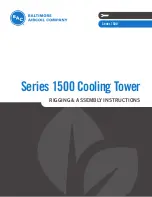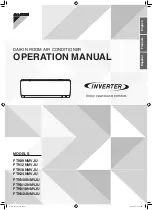
3 INSTALL THE REFRIGERANT PIPE
Execute heat insulation work completely on both sides of the
gas piping and liquid piping. Otherwise, this can sometimes
result in water leakage.
(When using a heat pump, the temperature of the gas piping can
reach up to approximately 120 . Use insulation which is
sufficiently resistant.)
Before rigging tubes, check which type of refrigerant is used.
All field piping must be provided by a licensed refrigeration
technician and must comply with the relevant local and
national codes.
Use a pipe cutter and flare suitable for used refrigerant.
Do not mix anything other than the specified refrigerant, such
as air, etc.., Inside the refrigerant circuit.
Coat the flare both inside and ouside with ether oil or ester oil .
If the refrigerant gas leaks during the work, ventilate the area.
A toxic gas is emitted by the refrigerant gas being exposed to
a fire.
Make sure there is no refrigerant gas leak. A toxic gas may be
released by the refrigerant gas leaking indoor and being
exposed to flames from an area heater, cooking stove, etc.
8
Also, in cases where the temperature and humidity of the
refrigerant piping sections might exceed 30 or Rh80%,
reinforce the refrigerant insulation(20mm or thicker).
Condensation may form on the surface of the insulating material.
Only use annealed material for flare conncetions.
Coat here with ether oil or ester oil
Precautions
3.1 Flaring the pipe end
1) Cut the pipe end with a pipe cutter.
2) Remove burrs with the cut surface facing downward so that the
chips do not enter the pipe.
5) Check that the flaring is properly made.
Refer to the table below for the dimensions of flare nuts spaces
and the appropriate tightening torque. (Overtightening may
damage the flare and cause leaks.)
Pipe gauge
(mm)
Outer diam.
(mm)
Tightening torque
A(mm)
Max.
1.3
1.6
1.8
2.2
Min.
0.7
1.0
1.0
2.0
Flare dimension
A (mm)
Flare shape
O6.35
O6.35
15~16 N. m
(153~163 kgf.cm)
8.3~8.7
12.0~12.4
15.4~15.8
18.6~19.0
25~26 N. m
(255~265 kgf.cm)
35~36 N. m
(357~367 kgf.cm)
45~47 N. m
(459~480 kgf.cm)
O9.52
O9.52
O12.7
O12.7
O15.9
O15.9
R0.4~0.8
45
2
90 4
A
o
o
1 Torque wrench
2 Flare nut
3 Piping union
4 Spanner
1
2 3 4
Align the centres of both flares and tighten the flare nuts 3 or 4
turns by hand. Then tighten them fully with the torque wrenches.
3.2 Refrigerant piping
Check whether the height drop between the indoor unit and
outdoor unit, and the length of refrigerant pipe meet the following
requirements:
Capacity
Btu/h
(
)
The type of models
Max.allowable
piping length
25m
50m
<15000
R410A inverter
Split type air
conditioner
Max.allowable
piping height
10m
25m
30m
65m
>15000~<24000
>24000~<36000
>36000~<60000
20m
30m
Cut exactly at
right angles.
Remove burrs.
Flare
'
s inner surface
must be flaw-free
The pipe end must
be evenly flared in a
perfect circle.
Make sure that the
flare nut is fitted.
3) Put the flare nut on the pipe.
4) Flare the pipe.
Die
Copper pipe
A
Set exactly at the position shown below.
3.3 Purging air and checking gas leakage
When piping work is completed, it is necessary to purge the
air and check for gas leakage.
WARNING
Do not mix any substance other than the specified refrigerant
into the refrigeration cycle.
When refrigerant gas leaks occur, ventilate the room as soon as
possible.
The specified refrigerant should always be recovered and never
be released directly into the environment.
Use a vacuum pump for the specified refrigerant. Using the
same vacuum pump for different refrigerants may damage the
vacuum pump or the unit.
If using additional refrigerant, perform air purging from the
refrigerant pipes and indoor unit using a vacuum pump, than
charge additional refrigerant.
Use a hexagonal wrench(4mm) to operate the stop valve rod.
All refrigerant pipe joints should be tightened with a torque
wrench at the specified tightening torque.
1) Connect projection side of charging hose (which comes from
gauge manifold) to gas stop valve's service port.
2) Full open gauge manifold's low-pressure valve (Lo) and
completely close its high-pressure valve (Hi)
(High-pressure valve subsequently requires no operation.)
3) Do vacuum pumping and make sure that the compound
pressure gauge reads -0.1MPa (-76cmHg).*1
4) Close gauge manifold's low-pressure valve (Lo) and sop
vacuum pump.
(Keep this state for a few minutes to make sure that the
compound pressure gauge pointer does not swing back.)*2
5) Remove caps from liquid stop valve and gas stop valve.
6) Turn the liquid stop valve's rod 90 degrees counterclockwise
with a hexagonal wrench to open valve.
Close it after 5 seconds, and check for gas leakage.
Using soapy water, check for gas leakage from indoor unit's
flare and outdoor unit's flare and valve rods.
After the check is complete, wipe all soapy water off.
7) Disconnect charging hose from gas stop valve's service port
then fully open liquid and gas stop valves.
(Do not attempt to turn valve rod byond its stop.)
8) Tighten valve caps and service port caps for the liquid and
gas stop valves with a torque wrench at the specified torques.
*1. Pipe length vs. Vacuum pump run time
9
3.5 Refrigerant pipig work
Pipe length and refrigerant amount:
Connective
pipe length
3.4 Additional refrigerant charge
CAUTION
Refrigerant may only be charged after performing the leak
test and the vacuum pumping.
Check the type of refrigerant to be used on the machine
nameplate. Charging with an unsuitable refrigerant may
cause explosions and accidents, so always ensure that the
appropriate refrigerant is charged.
Refrigerant containers shall be opened slowly.
The outdoor unit is factory charged with refrigerant. Calculate the
added refrigerant according to the diameter and the length of the
liquid pipe of the outdoor unit/indoor unit connection.
1) Caution on the pipe handling
Protect the open end of the pipe against dust and moisture.
All pipe bends should be as gentle as possible. Use a pipe
bender for bending.
Be sure to add the proper amount of additional refrigerant.
Failure to do so may result in reduced performance.
Pipe length
Up to 15m
More than 15m
Not less than 15min
Not less than 10 min
Run time
*2. If the compound pressure gauge pointer swings back,
refrigerant may have water content or a loose pipe joint may
exists. Check all pipe joints and retighten nuts as needed,
then repeat steps 2) through 4).
Be sure to
place a cap.
If no flare cap is
available, cover the
flare mouth with
tape to keep dirt or
water out.
Wall
Rain
Less
than 5m
More
than 5m
Air purging
method
Use vacuum
pump.
Use vacuum
pump.
Additional amount of refrigerant to be charged
R410A: (L-5)x15g/m
Liquid side: 6.35mm
R410A: (L-5)x30g/m
Liquid side: 9.52mm
11
kaisai.com


































